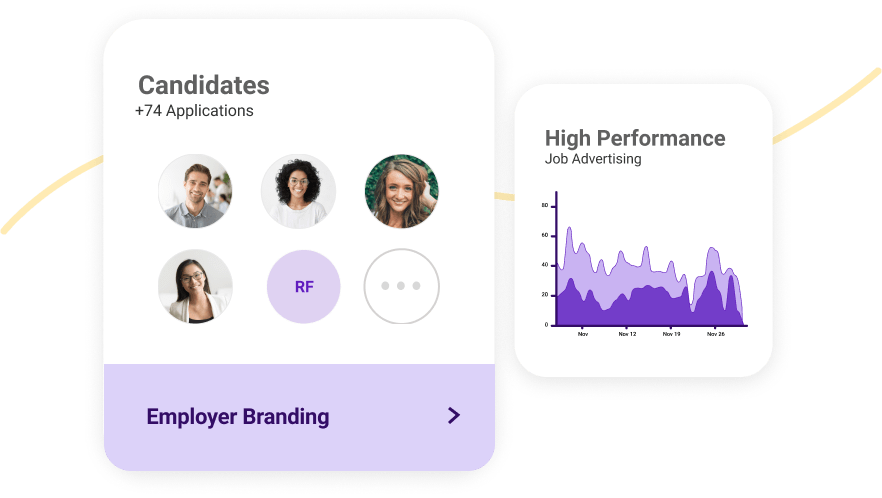Challenges That Come with High-Volume Recruiting
High-volume recruitment is more challenging than simply filling more jobs conventionally. When hiring at scale, there are many factors that can substantially impact your success in the talent market.
Here are a few of the common volume recruiting challenges that we’ll cover:
- Attracting the right candidates
- Talent sourcing issues
- Time constraints
- Bias-free hiring
- Agency-specific challenges
- Selecting the right candidates
Attracting the Right Candidates

One of the biggest issues recruiters face today is the talent shortage. Put simply: quality workers are hard to find.
Many recruiters don’t get enough applicants. What can be even worse: not getting enough experienced ones. It is not that there aren’t qualified people out there – we know that there are. It is about how you find and engage them.
For some recruiters and in some fields, it may be the exact opposite issue. Getting too many applicants, especially when they’re irrelevant or unqualified, can result in wasted time and money trying to find the right candidate.
Here are our recommendations for ensuring that you get the qualified applicants you’re looking for.
Build a strong employer brand
Job seekers care about a few key things when they’re applying for a position: who they’ll be working for, what they’ll be doing, and how much they’ll be compensated for it. Though the latter two are arguably more important, an employer’s brand is a huge piece of the puzzle.
Your employer brand should be at the heart of your recruitment marketing strategy. What are you like as an employer? What would your employees say about working for you? What benefits (beyond pay) do you have to offer? Use your careers page or blog to write about your company culture in an inviting way that draws people in.
When you figure out what makes working for you worth it and learn to communicate that effectively (via a careers site and social media), you’re sure to get more qualified applicants.
Optimize your job ads
Job ads should be optimized to meet your needs and reach your target candidate audience. What a lot of recruiters don’t realize is that you can edit your job ads in small ways to better meet your goals. People are more likely to apply when they’re qualified, and steer clear when they’re not. With a little bit of tweaking, you can better solve the problem you’re having with hiring.
If you aren’t receiving the number of candidates you want, you’ll want to consider if your expectations are unrealistic. Companies that are less flexible on requirements often miss a lot of capable candidates. A job seeker with one or two years less experience than your job ad requires may be too hesitant to apply or, if they do apply, be filtered out of consideration by your applicant tracking system (ATS) because they don’t check that one box.
If you’re reaching too many under-qualified candidates, you can optimize your ads by taking the opposite route. Be specific and strict with your expectations. Being clearer in your expectations can deter under-qualified job seekers from applying. That will leave your candidate pool looking shinier than ever.
The next piece of making excellent job ads is optimizing your titles. Job titles are prime real estate and you only have a few characters to work with. Remove the unnecessary details and lead with things that will entice your target candidate to apply. For example, titles with wage or salary in them tend to perform better – perhaps because skilled workers know their worth and only apply to positions that pay what they expect to make.
Do research on what your target candidate audience is looking for in a position. Find out what benefits they find most exciting, what pay they are willing to work for, etc. Use a tool like Talroo Insights to better understand who you’re targeting and what they’re looking for.
Some general job ad optimization options to consider are:
- Implementing readability optimization
- Including supplemental info (salary, perks, etc.)
- Optimizing job titles
Get employee referrals
Where you’re looking for candidates can have a major impact on who you find. A dedicated piece of your high-volume candidate sourcing strategy should focus on employee referrals. Who better to help you find quality candidates than someone who once was one?
Job seekers trust their friends and network more than they trust recruiters. Use this to your advantage. Incentivize employee referrals for both the referrer and the referee and see returns.
Looking for ways to incentivize employee referrals? Try these:
- Determine an incentive value for distinct roles and advertise it to employees through emails and/or other internal communication platforms. Some companies offer a bonus to both the referrer and the referee!
- Incorporate gamification. People love games and sometimes this is just the motivation employees need to think harder about getting you in touch with the talent they’re connected to. An office-wide leaderboard showing “most referrals” and offering a prize of choice to the winner is a great example of a way to do this.
- Think of opportunities and experiences that your employees would enjoy competing for that aren’t just monetary. Hot prizes like AirPods or speakers are enjoyed by most everyone, so they’re always good to consider. Local experiences are a great option, too. Taking it a step further, there is nothing more precious than the gift of time. Consider giving paid vacation days to employees who deliver on referrals, or even contribute money along with the time off.
These tips will help you tackle the most common challenge in high-volume recruiting: lack of qualified candidates.
Talent Sourcing Issues

Speaking of where candidates come from, how does your high-volume sourcing strategy hold up? If you’re not receiving the number of applicants you want, it may be a sourcing issue.
Do you have a multichannel recruitment strategy in place that’s looking for job seekers across platforms? If not, you should – casting a wide net is the best way to diversify your audience.
We’ll show you the most important channels to leverage.
Job boards
Job boards are the first place most recruiters turn to when looking to get a lot of candidate views. These are an effective way to increase application numbers. That doesn’t necessarily mean that they’re all qualified leads, though.
While there are many ‘best job board’ lists for you to use, don’t forget to consider more niche boards as well. They can be more relevant to the positions you’re offering than general destination sites. Job boards that are relevant to your industry can lead to more qualified applicants. Those focused on local areas can get you more intentional applicants.
Talroo Pro can help you reach candidates on thousands of niche job boards →
Social media
A multichannel recruiting strategy often means social media, at a minimum. Incorporating social media into your high-volume recruiting strategy is more important than you might think. You can use it to advertise job availabilities, as well as to show off your awesome company culture.
If you don’t know your company’s marketing team well, now is the time to get acquainted. Ask them to conduct a social media analysis to see how each of your platforms are performing. Then, work together to incorporate recruiting into your social media marketing strategy.
Word-forward platforms like Twitter are great for sharing content and starting conversations. Picture- and video-forward platforms like Facebook and Instagram are great for promoting organization events, benefits, or even individual jobs! Finally, LinkedIn is the primary “professional social network.” Even if you don’t use it to advertise jobs, you can still post and promote professional opportunities, both to your company’s following and to your own network.
Examples of how to use social media to find a high volume of candidates:
- Reach people where they’re already active. People will use social media whether you do or not, so it’s smart for your brand to be there both awaiting attention and promoting relevant content, conversations, and job opportunities where people will see them.
- Utilize employer branding (brand marketing) to engage people. This may attract passive candidates, active job seekers who click through to your page based on your branding, or any other interested followers.
- Diversify traffic sources. When you get to the stage of the recruitment process that involves analyzing metrics, you’ll pay a good amount of attention to source of hire. Expanding your number of sources (especially for cheap, like with social) is a great way to cast a wider net and reach more candidates across the internet.
Hiring events
Job fairs and hiring events can be great ways to find and engage a different candidate audience.
Promotion and logistics matter a lot here. However, once set up, hiring events can greatly improve your conversion rate. If someone is showing up to a job fair, they’re either interested in your company specifically or are looking for an immediate opportunity. These events allow you to get face to face with just the crowd you’re looking for.
Even though many industries have gone virtual for the better part of a year now, events can still have a large ROI when it comes to application numbers. Online events are a solid option for a new sourcing avenue and offer their own benefits like scalability and geographic segmentation.
Nail these steps and you’re on a great path to better sourcing.
Time Constraints

Vacant positions cost money in most fields, and that means that the clock is constantly ticking. Hiring can take months, but for high-volume recruiters, you don’t have time to waste.
True efficiency in hiring is hard to achieve but it’s not impossible. There are tools available that help make the process faster and your job easier.
Follow these tips to improve your high-volume hiring speed.
Automate your recruiting process
The number one way to make your hiring process more efficient is by using technology. Thankfully, there are more recruiting tools and HR technology than ever before.
Many recruiters are hesitant to lose the human touch that is so valued in recruiting. Yet, many others are turning to automation to get things done quicker – and loving it.
At the very least, a comprehensive ATS is a great method for speeding up time to hire. They automate many of the repetitive tasks: interview scheduling, managing resumes, and more. If you’ve been in high-volume hiring awhile, you might already be using one.
Are you using integrations, too? Connecting your ATS with job boards, social platforms, and email tools can make for faster promotion. Integrating with file storage tools can also be an effective way to promote in-house efficiency. Talroo is compatible with most major ATSs on the market.
Look into what top players in your space are using to consider adding to your automation methods. Research the top HR technology in the game for more ideas.
Beyond reducing time to hire, incorporating better tech into your strategy can also help you:
- Lower your marketing expenses
- Improve candidate communication
- Keep candidates moving through your funnel
- Achieve a higher quality of candidates
Engage passive contacts
Lots of the working population aren’t actively seeking a job. Many people are employed and doing fine. That doesn’t mean that they wouldn’t consider a better offer if it came their way.
Job boards are not the way to engage these kinds of candidates. Stay on the radar of these individuals by keeping your employer branding alive and well. That includes your social media accounts, your incentives for referrals, and more to catch the eye of those who might be interested in you later.
Using multiple recruiting channels isn’t only good for sourcing – it’s a time saver, too. It is always good to diversify your channels instead of leveraging one too heavily. Being too reliant on any one channel is risky.
Get more eyes on your jobs and maintain interest in your company through the long-term strategy of passive candidate engagement.
Be reasonable about your timeline
While it’s always nice to beat the clock, sometimes timing is more about expectations than anything else. If your current recruiting goals or timelines are unrealistic, remind your leadership of what an achievable recruiting timeline looks like.
When preparing to talk to leadership about adjusting their expectations, consider what they want to hear about: numbers, expenses, and ROI. Provide them with data (number of hires, source of hires, current time to hire, etc.) tied to expenses and take it home by relating it to the benefits to be gained from adopting a different timeline. Based on the metrics you track, make the business case by estimating how many quality hires you could make in their allotted time vs. a timeframe you think is more manageable.
The other side of this is to put yourself in the shoes of leadership. Perhaps their proposed timelines are unreasonable, or maybe there really are parts of the process you could improve that’ll allow you to achieve more hires in a shorter amount of time than you thought possible. Do not let yourself get held back by unwillingness to try out new technology, work with a different team, or diversify via various channels.
Bias-Free Hiring

Many companies struggle to get the diverse candidates they’re looking for. Some realize, way down the line, that they’ve been hiring people from schools like the ones they went to, or people who have worked for companies like that ones they worked for.
It’s easy to get comfortable in your way of doing things, but sometimes this can cause you to unintentionally miss great hires. For example, certain job requirements or interview questions might be causing your candidates to self-select out.
Creating an inclusive workforce starts with HR, and it’s up to you to make the change.
Establish hiring goals and team-building events
Start by setting hiring goals and bias-free standards. Look at where your company is at now culture and demographic-wise. This will help you decide if establishing metrics to watch would help where you stand.
Moving beyond goals, establish trainings that teach people about examples of biases in the workplace, things considered unfair workplace practices, and celebrating different backgrounds. Host team-building events where coworkers can learn more about each other, build camaraderie, and celebrate each other’s idiosyncrasies. These types of trainings can be helpful in reminding people that while we all come from different backgrounds and celebrate different things, we are all on the same team.
This is a long game strategy, but it generally has a positive affect towards employees, that can extend to the other things they do like reviewing applications, interviewing candidates, etc.
Make your job postings more inclusive
Did you know that certain language you’re using in your job ads might be deterring certain candidates from applying? One way to reduce bias and attract bigger audiences in job ads is by through readability optimization. This addresses things like gender analysis, complexity of language, etc. Use tools like a readability tool or gender decoder to learn how your ads may read to different groups of people.
Some readability optimization tools to consider:
You’ll want to start optimizing for inclusivity as early as possible in the application process. This helps ensure you’re reaching and engaging the maximum candidate audience. ATSs can be effective at scanning and assessing simple metrics like education and experience. However, it’s probably missing some softer skills that make an applicant special.
Consider adding things like values alignment tests or culture-fit assessments to your application process to see how well a candidate fits your company based on more than their resume.
Conduct your interviews with D&I in mind
Throughout an interview process, there are many ways unintentional bias can creep in and negatively affect your hiring efforts. One straightforward way to mitigate this is by standardizing your interviews. Ask all candidates the same questions to make sure you judge them against the same criteria. Of course, you can leave room for other organic conversation and for candidates to mention skills or experiences that aren’t reflected about them on paper. Don’t be too rigid about candidates checking certain boxes, but keep in mind that each candidate should be treated fairly and launch off the same starting point.
Another method for conducting interviews fairly is to use multiple interviewers. This is helpful to ensure that one person is not swayed by personal preference or similarities over a candidate’s skills and culture fit. The more diverse your panel, the better.
Diversity and inclusion is ultimately about assessing all candidates equally as individuals. A high-performance interview process that takes advantage of diversity and inclusion best practices will:
- Engage a broader range of candidates
- Reach a larger audience
- Build a more resilient workforce
- Discover hidden talent your competitors are missing
Agency-Specific Challenges

In-house recruiters will undeniably face different issues than those at staffing firms. High-volume agency recruiters often have to hire for a variety of clients. Spanning various industries, these recruiters are often expected to bring in more candidates for consideration than their in-house counterparts.
Agencies do have some advantages, like the lowered overall cost of recruiting technology since its use spans the company. Still, their job comes with different, specific challenges. Some of these might include:
- Maintaining organization across projects
- Clients being hesitant to follow recommendations
- Keeping up with changing talent trends
Here is what we recommend:
Get organized by going digital
Every modern worker has had to embrace technological transformation of some kind. Recruiting is no different. Agency recruiters, especially, need a high volume of applicants and benefit from taking their work digital.
Going digital in and of itself can present a challenge for many TA professionals. Keep an open mind and get training opportunities set up and on the calendar. Make it a priority to only work with vendors who have customer service as a core value.
Here are some examples of aspects of the high-volume agency recruiting that tech can make faster or easier:
- Email automation for repetitive or generic communication
- Interview scheduling
- Chatbots for easy questions that can be answered quickly with prepared responses
- Qualifying questions for pre-qualifying candidates
Encourage clients to trust your expertise
As a talent acquisition professional, you’re expected to be a recruiting expert compared to your client. However, some clients require significant effort and results to demonstrate agency expertise.
For example, we know that the number of ways that employers must fight to stand out among candidates are continuously growing. Your agency might choose to advise a client on how a minor change to job requirements, like reducing experience by one year, could cause a substantial improvement to their application volume and candidate quality. A client may be reluctant to take advice like that unless they really trust you.
Back up your claims with data whenever possible. Show them what percentage increase in qualified applicants you’re expecting in a given timeframe if they implement a change you recommend. Use your metrics and labor trends research to strengthen your point. If possible, use case studies and positive reviews to prove your credibility as an agency.
See how Talroo Insights can help demonstrate agency expertise →
Keep up with talent trends
It’s especially important for an agency recruiter to be up to date on the latest staffing trends. Agencies are often fortunate to have significant depth of expertise in recruitment across many industries. Clients may not have the breadth of experience, but you can win hearts and minds if you help bridge the gap.
Make it a priority to stay updated on every avenue of talent trends such as:
- Labor market standings
- Client’s competitive landscape
- New legislation
Our recommendation is to set yourself up for success by automating your industry learning and discovery process.
Try subscribing to e-newsletters about workplaces like Staffing Today or SHRM. Find a few trustworthy recruiting blogs and subscribe so you’ll have a constant flow of recruiting news and tips. Finally, for news and politics, find a source you trust (maybe a few on both sides of the aisle), to stay updated on the latest in labor market news.
Staffing agency life isn’t as creative as marketing agencies, but it is just as difficult. Follow these tips to solve your high-volume staffing challenges.
Selecting the Right Candidates

The Rube Goldberg machine of a recruitment process has finally led you to this point! You are almost home free, but a misstep at this point could cost you time, money, and productivity.
Let’s revisit several core components of recruitment to ensure we select the best possible candidates.
Use multiple assessments
Fairly often in recruiting, someone seems great for a position on paper. However, when push comes to shove, they’re just not right for the company. One way to avoid this is by incorporating assessments into your recruiting process.
Here are some popular assessments employers incorporate into their recruiting:
Tests allow people who have great resumes but misaligned values to be on more equal footing to people who may not meet the exact requirements but could fit well into the culture or have skills that a resume doesn’t show. They are best used to help level the playing field.
At Talroo, we use an assessment that allows us to see if people have the skillset and work ethic we’re looking for before moving them forward to the interview stage. Some of the features include “ability to work well with others,” “trustworthy,” and “excited to take on new challenges.”
Get the most out of your ATS
Most ATSs have internal features that allow you to manage requisitions easily. You can sort through candidates and highlight your best applicants. A skill parsing tool could be a helpful feature to weed through your candidates and assess how well they fit a role.
Other features in ATSs lighten the load of high-volume recruiting. Using a scorecard (even in conjunction with assessments) can improve hiring efficiency. Scorecards quantify candidates along their applicant journey, making it easier to see great fits.
Embrace hiring as a team
Even if you do not have the bandwidth to have multiple interviewers present for each applicant, having a hiring team that works together is a safe way to have checks and balances on your recruiting process.
The opinion of the entire team matters here. However, there should always be a leader in charge who can make the final call if things get dicey.
Selecting the right candidate is the last step in the recruiting process, and it can sometimes be difficult to come to a decision. That is why it takes a village – or in this case, a team – to work together to improve your quality of hires.
Overcoming High-Volume Recruitment Challenges
Recruiting isn’t easy. Some recruiting processes suffer from inefficiency. Others are just products of a crowded employer market and a talent shortage. Regardless, the workforce is constantly changing, so your recruitment process must also change to keep up.
Thankfully, we love recruitment challenges. At the end of the day, high-volume recruiting is about people, and Talroo connects people with opportunity.
Discover how Talroo Pro can help source candidates more effectively.
See more of our high-volume recruiting guide →



